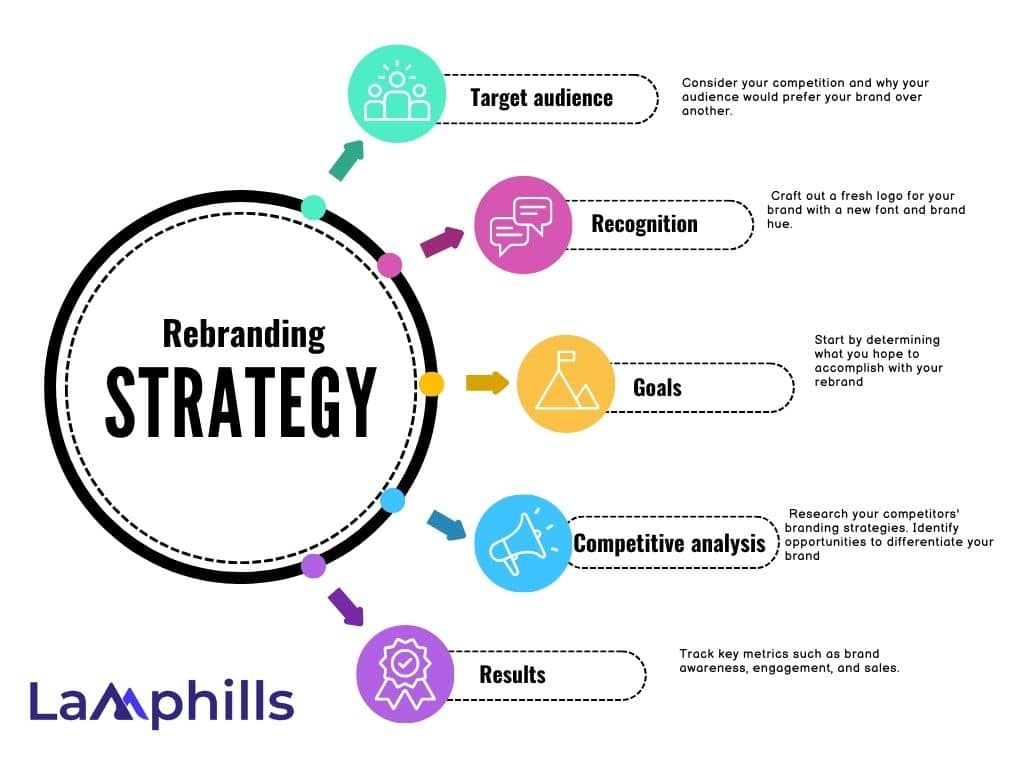Rebranding can be a powerful tool for businesses looking to strengthen their brand perception, attract new customers, and boost growth. Additionally, when done the right way, rebranding indeed helps brands or businesses stand out from fierce rivals and competitors, hence creating long-lasting impressions on customers and the brand as a whole. I don’t need to remind you of our anchor topic, “top rebranding strategies that spark massive business growth and overall, triple your brand’s visibility. If you are a business owner, I will humorously suggest that you grab a pack of popcorn, fasten your seatbelts, and read attentively since we have a journey to make. Read on!
- A comprehensive rebranding approach covers all aspects of your company’s identity, including the logo, motto, website, marketing materials, mission statement, and objectives. Most of the time, rebranding is a natural part of the growth process, and it is done to reflect market developments and customer expectations. However, in other cases, rebranding occurs following mergers and acquisitions by other corporations.
- A rebranding is never just about replacing logos and graphic elements. The most effective rebrands are strongly driven by great brand strategy, which frequently includes an extensive re-evaluation of business and marketing strategies, pricing, messaging, improved digital and physical presences, and, of course, design.
- Businesses undergo rebranding in the case of a merger, product line extension, leadership change, to keep up with changing client needs, to reposition a brand, or to eliminate an existing negative brand image. As a start up or existing business, while effective rebranding methods may be applied to both new and existing services, you must be aware of the complexities involved.
Rebranding Strategy
Rebranding is a marketing approach that involves changing the image, identity, or position in the marketplace of an existing company or product. It may involve updating the company’s name, logo, packaging, website, marketing materials, and messaging to better correspond with its objectives and target audience.
Overall, rebranding is basically employed to update an outdated image, appeal to new client segments, reflect business developments, or distance itself from bad connections. A successful rebranding initiative aims to positively impact customers and stakeholders, raise brand awareness and loyalty, and eventually promote corporate growth.
Rebranding may be the only viable path to growth for a company at some point in its existence. And, as I mentioned in the introduction, if done strategically, your brand can emerge stronger than before.
These are the strategies that drove some of the world’s largest businesses to rebrand, as well as how their customers reacted.
My Testimonial of How Rebranding Helped My Brand
Earlier last year, our brand was struggling to stand out in a crowded market. Sales were stagnant, and customer engagement was low. And as a brand, realizing we needed a change, we decided to engage on a rebranding strategy. This decision spearheaded the beginning of a transformative journey for our business.
Firstly, I and my team conducted extensive market research to understand our target audience better. This further led us to refine our brand identity, focusing on what truly resonated with our customers. Consequently, we revamped our logo, updated our color palette, and crafted a new, compelling tagline that portrays our brand’s mission.
Next, we overhauled our website and social media presence. By creating a user-friendly, visually appealing online experience, we aimed to attract and retain more visitors. Additionally, we developed fresh content that highlighted our brand values and showcased customer success stories. This strategy not only improved our online engagement but also fostered a stronger connection with our audience.
Furthermore, we launched a targeted marketing campaign to spread the word about our rebrand. We used a mix of digital advertising, email marketing, and influencer partnerships to reach a broader audience. As a result, our brand visibility skyrocketed, drawing in new customers and re-engaging existing ones.
Gradually, we began to see the impact of our efforts. Customer feedback was overwhelmingly positive, and sales started to climb. Our social media following grew, and website traffic increased significantly.
In conclusion, the rebranding strategy was a game-changer for our business. By understanding our audience, refreshing our brand identity, and effectively communicating our new vision, we were able to turn our fortunes around. Today, our brand is stronger than ever, thanks to the strategic rebrand that set us on a path to success.
How to Create a Rebranding Strategy

Creating a rebranding strategy is not a day’s job. Just like the popular saying “Rome was not built in a day.” Creating a rebranding strategy takes time, effort, and money. However, a successful rebrand can create a strong brand with loyal customers and a different identity from competitors altogether. You can use these steps curated below to plan your company’s rebrand:
#1. You need to target a new demographic.

When building a brand, you want to create something long-lasting. Still, younger consumers may not always think that older is better. You may already have an acute understanding of your company’s target demographic, but a rebrand could bring in new clients with diverse interests. Identically, determine the target audience for your branding, whether it be current or potential clients, and paint a clear image of who they are and what would entice them to use your goods or services. Consider your competition and why your audience would prefer your brand over another.
#2. Identify objectives
This is the first step to embark on. Start by determining what you hope to accomplish with your rebrand. You might decide to attract a new market by changing the tone of your brand, or you may want to separate your brand from the company’s past. Try to be explicit about what you want the new branding to accomplish and set achievable targets.
#3. You need to differentiate your brand.
It will be difficult to build brand loyalty and achieve growth if people perceive your brand as being too similar to that of your competitors. A rebrand is an effective method for helping your company stand out in the minds of consumers. Target’s rebranding is an excellent illustration of how this strategy may yield great results.
#4. Create new recognition
With the use of your new mission statement, develop new versions of brand elements that somewhat resonate with your new path. Craft out a fresh logo for your brand with a new font and brand hue. Create messaging with a brand personality that establishes the right tone to showcase your new focus. Creating new identity has to do with Revamping your Website and digital presence:
- Redesign your website to align with your new brand identity
- Refresh your social media profiles and online content
Your new brand recognition will somehow affect the whole firm, therefore involve the entire team, including your marketing professionals, designers, sales team, and other stakeholders.
#5. Conduct a competitive analysis:
This step needs no longer explanation. As a brand, what makes you distinctive and gives you this thriving mentality in a hungry market is the ability to study your rivals’ weakness and use it to your benefit. Research your competitors’ branding strategies. Identify opportunities to differentiate your brand and stand out in a crowded and hungry market.
Related: Top 10 Keyword Research Services in 2024
#6. Monitor and measure results:
Track key metrics such as brand awareness, engagement, and sales. Once you’ve decided on a new brand identity that you believe will push your company forward, it’s time to put it into action. You must include your new graphic components and language into marketing materials, your website and social media accounts, physical locations and materials like product packaging, and internal communications. Plan ahead of time and shortly install your new brand to avoid confusing your clients with your old identity.
Continuously evaluate the effectiveness of your rebranding efforts
#7. Maintain Consistency:
Maintaining consistency in content, design, and user experience is crucial for creating a cohesive and professional brand identity. Consistency is important and how you can achieve it across your platforms really matters. Ensure consistency in your branding across all channels and touchpoints. Continuously reinforce your new brand identity across media outlets, press releases and so on.
Rebranding Strategy Templates
A rebranding strategy like I said in the context above, is a detailed plan of action designed to completely revamp and reset a company’s or organization’s brand identity to better align with its current goals and objectives. It involves a complete transformation of the brand’s visual and verbal aspects, including its name, logo, tagline, messaging, and communication style.
✍️Top Takeaway:
Rebranding isn’t only about making aesthetics changes; it can also involve improving the overall customer experience.
Getting feedback and insights from clients is never old-fashioned. It helps you understand how customers view your brand, what they expect and how they prefer to have it. These insights help you align rebranding efforts with your audience's needs and expectations.
This rebranding strategy template is for any companies looking to rebrand their business. It is specifically designed for teams of all sizes and industries and provides a detailed basis for the planning and execution of the rebranding process.
Gathering feedback and insights from customers never goes out of style. It helps you understand how customers perceive your brand, what they expect and how they prefer to have it. These insights help you align rebranding efforts with your audience’s needs and expectations.
What is contained in this template for a rebranding strategy?
3 main areas of interest
three objectives
three initiatives
In order to guarantee that the strategy is thorough and efficient, every emphasis area has its own goals, initiatives, and key performance indicators.
Rebranding Strategy Examples
In this section, I compiled some compelling examples of how brand strategy should always guide rebranding. So, without further ado, find out why these brands make our current shortlist of the Top Iconic Rebrands of All Time! The lessons from each are vital to your brand’s success.
#1. Apple’s Rebranding Strategy
First on this selected list of examples is the iconic Apple’s rebranding strategy. Not many of us know this but years back, Apple was on the verge of folding up.
Some years back, Apple was in big trouble, almost going bankrupt around 1997. They had low sales, few customers, and lots of competition. This continued going on not until Steve Jobs came into the equation.
How did it happen? You may ask
Steve Jobs came back to Apple and changed everything.
How?
First, he made Apple focus on being simple and innovative. This new approach caught everyone’s attention. They created amazing products like the iPod and iPhone. These gadgets were so easy to use and worked so well together that Apple became more than just a tech brand; it became a part of people’s daily lives.
Thanks to these changes, Apple went from struggling to being the most iconic brand ever.
Apple sold its vision to the world of simple technology that makes your life easier — even better — and in doing so, it tapped into a universal emotional motivation that still underpins its brand power today.
#2. Lego Widens its Audience.
Image source: Business Insider
The Lego rebranding is interesting. As you can see, the company’s logo, color palette, and overall visual identity remained largely unchanged. However, when developing a new identity, it is important to consider both the outer and the inside.
The iconic toy manufacturer completed one of the most dramatic transformations in history just by recognizing its larger audience. It established new digital channels to engage children and their parents, reestablishing the brand’s relevance.
In addition to games and television shows, Lego movies were developed. Furthermore, the company began investing in a completely new strategy: manufacturing distinctive toys for grownups. After all, people of all ages enjoy making things, correct?
Do you know the outcome of this?
Well, sales increased significantly as a result.
#3. Burberry’s Significant Rebranding
Burberry seemed to be well on its way out of the market for exclusive brands in the early 2000s. The brand, previously considered stylish and premium, had become connected with a subculture that, according to the Financial Times, was “prone to drinking and antisocial behavior.” This was far from the image the brand wished to convey.
Following Angela Ahrendts’ arrival as CEO in 2006, the brand was eager to confront and address its image issues. Ahrendts thought that the appropriate influencers could bring about a significant change.
Soon enough, well-known public figures carefully chosen by the company contributed to its excellent publicity. Its rebranding attempt appears to achieve the expected result, as perception of the company has changed.
What are the steps in rebranding?
Before you can successfully rebrand your firm, you must first ask yourself why it needs to be rebranded. Rebranding is not something you can do overnight. There are steps to achieve a great business rebranding that will bring an overall transformation to your business.
What are these steps?
A 7-Step Rebranding Campaign
- Start with identifying objectives
- Research your company and your target customers
- Use positioning and messaging to capture your Brand strategy.
- Build your brand identity.
- Build your website and online presence.
- Marketing collateral.
- Brand building plan.
What are the three elements of rebranding?
A complete rebrand includes new positioning, branding, and sometimes even a new name. When done correctly, the process should always begin with an assessment of your beliefs and vision, followed by the creation of a visual identity that is consistent with this approach.
What are the three types of rebranding?
Types of rebranding
- Brand merger.
- Brand refresh.
- Full rebranding.
“Sparkling Results: How Rebranding Can Ignite Long-Term Business Growth”
“Thinking of rebranding? Don’t dive in without a plan! Rebranding is a complex process that requires a deep understanding of your company and target audience. You need to conduct a thorough brand audit health check to gather valuable insights and feedback. This will help you create a solid brand strategy, which serves as the foundation of your business. Your brand strategy will guide your marketing, design, and communications efforts, ensuring a consistent message and visual identity.
Without a clear strategy, you risk getting lost in the process and failing to achieve your goals. Branding is more than just marketing or design; it’s the heart and soul of your business. So, take the time to get it right and set yourself up for success.
Did You Find this Article Interesting? Then Read
- 28 Popular Clothing Brands For Teens In 2024
- HOW TO MEASURE BRAND AWARENESS: Tips To Improve Your Brand Strategy
- 21 Event Press Release Templates & Examples That Inspires Me






